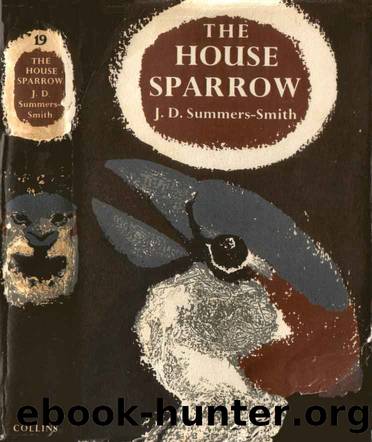The House Sparrow by J. D. Summers-Smith

Author:J. D. Summers-Smith
Language: eng
Format: mobi
Publisher: Thersby Group
Published: 2012-08-14T18:30:00+00:00
r broods in succession.
CHAPTER 12
DISEASE AND PARASITES
Very little is known about the causes of death in wild birds. Predation, disease, accidents and the hazards of migration each take their toll, though the significance of the different factors is not known for any particular species; indeed it may vary from season to season and year to year. The main reason for this lack of knowledge is that only a very small proportion of the birds that die each year are found and very few of these find their way to anyone sufficiently qualified to carry out a post-mortem examination. In recent years Dr. A. R. Jennings at Cambridge has asked for freshly dead birds to be sent to him. The sample obtained in this way is almost certainly a biased one; particularly with small birds it is most probable that the ones found have died from a violent accident or by poisoningâbirds weakened by disease or starvation are likely to be taken by predators and disappear without trace. Nevertheless, this investigation has already given some fascinating information.
Jennings154-158 has reported on the death of fifty house sparrows: twenty-four of these were caused by trauma; nineteen by poisoning and the remaining seven by disease, including coccidiosis, aspergillosis, pneumonia and enteritis. The pathogenic organisms responsible for disease are grouped into four classes: viruses, bacteria, fungi and protozoa, all of which have been reported from house sparrows in various parts of the world. The virus infections include colds286 and canary pox286, the bacterial ones anthrax303 (Bacillus anthracis) avian tuberculosis286 (Mycobacterium) pullorum disease286 (Salmonella pullorum) relapsing fever286 (Treponema anserinum) and equine encephalitis286,381. Two fungal parasites that have been recorded are Aspergillums fumigatus, a common mould of the soil that causes a disease of the lungs and air-sacs (aspergillosis), and a sarcosporidiun causing a disease of the muscles known as avian sarcosporidiosis286. It is not known how widespread any of the dis
DISEASES AND PARASITES
eases are among wild house sparrow populations. Coccidia, protozoan gut parasites, seem to be very common in sparrows; for example, they were present in forty three out of fifty-four birds examined at Princeton in the U.S.A311. All of these were healthy birds and it is not known why the balance is sometimes upset in favour of the protozoan and coccidiosis results. This gives rise to internal bleeding and may cause the death of the host. Another group of protozoans, which causes a disease of the white blood corpuscles, has been recorded from India, Italy, Great Britain and the United States. R. Lainson183 has recently investigated the life history of this parasite in British sparrows and has named the species Lankesterella (Atoxoplosma) garnhami; he found it to be present in all of ninety-nine adult and one hundred and fifty juveniles collected in Hertfordshire. This is an important pathogenic organismâLainson observed that it caused the death of a number of young birds.
Epidemics causing very large mortalities of house sparrows are known, though the organisms responsible have not been identified. J. M. Stenhouse321,322 reported an epidemic in
Download
This site does not store any files on its server. We only index and link to content provided by other sites. Please contact the content providers to delete copyright contents if any and email us, we'll remove relevant links or contents immediately.
Periodization Training for Sports by Tudor Bompa(7939)
Bodyweight Strength Training by Jay Cardiello(7685)
Therapeutic Modalities for Musculoskeletal Injuries, 4E by Craig R. Denegar & Ethan Saliba & Susan Saliba(7603)
Born to Run: by Christopher McDougall(6907)
Imperfect by Sanjay Manjrekar(5687)
Wiseguy by Nicholas Pileggi(5340)
Shoe Dog by Phil Knight(4916)
Paper Towns by Green John(4817)
The Body: A Guide for Occupants by Bill Bryson(4609)
The Rules Do Not Apply by Ariel Levy(4545)
Endurance: Shackleton's Incredible Voyage by Alfred Lansing(4523)
Bodyweight Strength Training Anatomy by Bret Contreras(4487)
Tuesdays with Morrie by Mitch Albom(4416)
Yoga Anatomy by Kaminoff Leslie(4114)
The Sports Rules Book by Human Kinetics(4089)
Science and Development of Muscle Hypertrophy by Brad Schoenfeld(3978)
Dynamic Alignment Through Imagery by Eric Franklin(3933)
Exercise Technique Manual for Resistance Training by National Strength & Conditioning Association(3793)
Bodyweight Strength Training: 12 Weeks to Build Muscle and Burn Fat by Jay Cardiello(3788)
